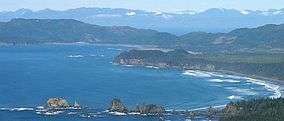Flattery Rocks National Wildlife Refuge
| Flattery Rocks National Wildlife Refuge | |
|---|---|
|
IUCN category IV (habitat/species management area) | |
 | |
 | |
| Location | Clallam County, Washington |
| Nearest city | Forks |
| Coordinates | 48°10′27″N 124°43′50″W / 48.1742290°N 124.7305159°W[1]Coordinates: 48°10′27″N 124°43′50″W / 48.1742290°N 124.7305159°W[1] |
| Area | 125 acres (51 ha)[2] |
| Established | 1907 |
| Governing body | U.S. Fish and Wildlife Service |
| Website | Flattery Rocks National Wildlife Refuge |

Flattery Rocks National Wildlife Refuge is the northernmost of the three refuges (along with Quillayute Needles and Copalis) which make up the Washington Maritime National Wildlife Refuge Complex, a group of 870 islands, rocks, and reefs extending for more than 100 miles along Washington's coast from Cape Flattery to Copalis Beach. These islands are protected from human disturbance, yet are close to abundant ocean food sources.[3] They are closed to the public, with wildlife observation only from boats and the mainland, and a 200-yard buffer zone surrounding each island.[4]
They are a vital sanctuary where 14 species of seabirds nest and raise their young. During migration the total populations of seabirds, waterfowl, and shorebirds may exceed a million birds. Sea lions, harbor seals, sea otters, and whales may also be seen around the islands.[3]
The refuge is within the boundary of Olympic Coast National Marine Sanctuary and Olympic National Park, and is also incorporated into the Washington Islands Wilderness. The three agencies cooperate on research programs and other issues that may have impacts on the resources.[3]
History
The refuge was originally created as Flattery Rocks Reservation on October 23, 1907, by an executive order from Theodore Roosevelt. It encompassed the islands off the Washington coast between latitudes 48° 02′ North and 48° 23′ North.[5] It was renamed by a presidential proclamation on July 25, 1940.[6]
See also
- Map of the Washington Maritime National Wildlife Refuge Complex
References
![]() This article incorporates public domain material from websites or documents of the United States Fish and Wildlife Service.
This article incorporates public domain material from websites or documents of the United States Fish and Wildlife Service.
- 1 2 "Flattery Rocks National Wildlife Refuge". Geographic Names Information System. United States Geological Survey.
- ↑ "Annual Report of Lands as of September 30, 2013" (PDF). United States Fish and Wildlife Service.
- 1 2 3 "Flattery Rocks National Wildlife Refuge Profile". U.S. Fish and Wildlife Service.
- ↑ "About the Refuge". Flattery Rocks National Wildlife Refuge. U.S. Fish and Wildlife Service.
- ↑ Executive Order 703, October 23, 1907.
- ↑ Proclamation 2416, July 25, 1940. Mentioned in the citations in the National Wildlife Refuge Administration Act.
External links
- Flattery Rocks National Wildlife Refuge U.S. Fish and Wildlife Service